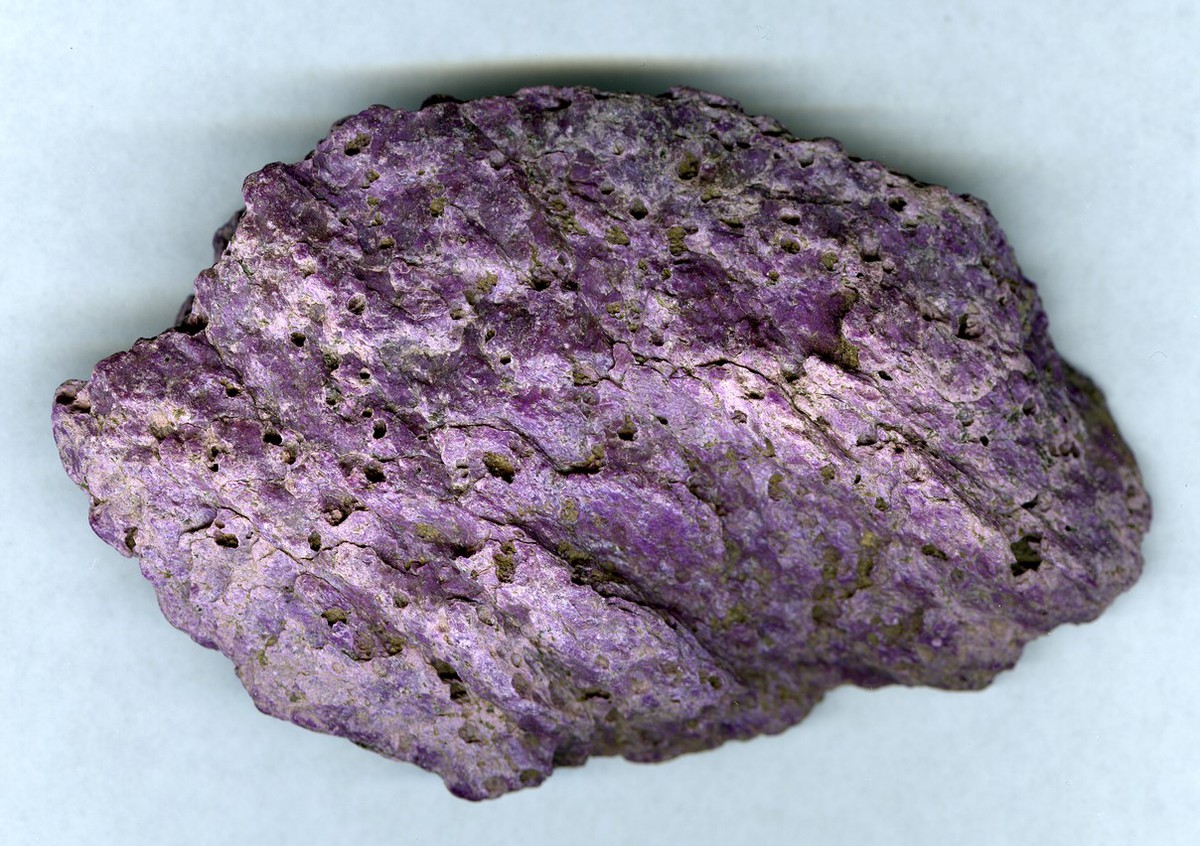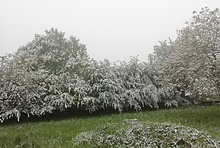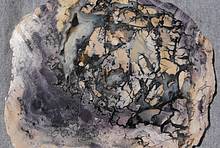Stichtite is an uncommon magnesium chromium hydroxycarbonate which belongs to the hydrotalcite group and forms a series with hydrotalcite, pyroaurite and woodallite. Barbertonite is a less common hexagonal polymorph that belongs to the sjögrenite group and may occur as intergrowths with some stichtite. Stichtite was known from Dundas since 1891 and was first recorded (albeit described incorrectly as “kammererite”, a chromian clinochlore) by Petterd (1896) after a specimen from there was exhibited at the Tasmanian Exhibition in Launceston in 1891 (Twelvetrees, 1914). It was later recognised as a new mineral by Petterd (1910), after chemical analysis by A.S. Wesley at the Mt Lyell mine, but Petterd died in 1910 before describing the mineral properly. It was formally described by Twelvetrees (1914) who sent material to Europe for more detailed analysis by several mineralogists and collated the various mineralogical data from Petterd (1914, description), Ward (1914, optics), Hezner (1914, chemistry) and Himmelbauer (1914, structure). It was named stichtite after Mr Robert Sticht, general manager of the Mt Lyell mines, and a world-renowned pioneering metallurgist and sponsor of Petterd’s first catalogue of minerals.
The original find and type locality was described by Twelvetrees (1914) as “the razorback crest of a ridge above the Adelaide silver-lead mine, Dundas”. This description corresponds well with the present workings on Stichtite Hill. A co-type sample is stored in the ENSM, Paris, France (Sutherland et al., 2000).
Australia
Tasmania, Macquarie Harbour, Birches Inlet, BHP prospectAustralian Journal of Mineralogy (2006) 12: 101-107
Tasmania, Zeehan District, Dundas mineral field, Adelaide Mine (Adelaide Pty Mine; Adelaide Proprietary Mine)
Anthony, J. W. et al. (1997): Handbook of Mineralogy, Vol. 3, 39
Tasmania, Zeehan District, Dundas mineral field, Bonanza Mine (Lucky Star Mine)
Australian Journal of Mineralogy (2006) 12: 93-99
Tasmania, Zeehan District, Dundas mineral field, Red Lead Mine
Bottrill & Baker (in prep) Catalogue of minerals of Tasmania
Tasmania
Zeehan District, Dundas mineral field, Stichtite Hill (TL)
Australian Journal of Mineralogy (2006) 12: 101-107
Tasmania, Zeehan District, Dundas mineral field, West Comet Mine
Bottrill & Baker (in prep) Catalogue of minerals of Tasmania
Tasmania, Zeehan District, North Dundas, Nevada Ck
Bottrill & Baker (in prep) Catalogue of minerals of Tasmania
Tasmania, Zeehan District, Dundas mineral field, Serpentine Hill, Tunnel Hill Quarry
Bottrill RS & Baker, WE (in prep) Catalogue of Minerals of Tasmania. Mineral Resources Tasmania
The five main stichtite deposits in Tasmania (Figure 1) are Serpentine Hill, Nevada Creek, West Comet, Stichtite Hill (probable type locality) and Birches Inlet (on Macquarie Harbour, about 100km south of Dundas). The Stichtite Hill area is presently being mined for stichtite and serpentine (mostly for carving and polishing: Bottrill and Brown, 2000; Figs. 2 & 3) and is one of the principal sources of stichtite specimens in the world. The lilac stichtite in a yellow-green to black serpentine matrix makes attractive specimens.
The stichtite deposits at Dundas are all hosted by generally massive serpentinite bodies, probably derived from altered chromite-rich dunites within mid-Cambrian ultramafic complexes, particularly the Dundas ultramafic complex (Brown, 1986; Burrett and Martin, 1989) These complexes are a series of thrust-emplaced, dismembered ophiolitic bodies along the Dundas Trough, which bisects western Tasmania. They were deformed and intruded by mineralised granites during the Devonian era (Brown 1986).The occurrences are erratic, both in size and distribution within the serpentinites, and some appear to be related to brecciation of the host serpentinite. The occurrences include zones with small spots of stichtite nucleated around chromite (Fig. 4), and zones with stichtite remobilised during deformation into coarser patches and irregular vein-like bodies (up to 20 cm across; Fig. 5). The latter style of occurrence is the main source of stichtite specimens for collectors.
Stichtite occurs as opaque to translucent, pale pink to lilac, orange (any photos of orange stichtite?), mauve or deep purple, fine-grained, massive to micaceous material with a waxy lustre. It commonly contains disseminated chromite-magnesiochromite grains (up to 1 cm diameter), which may be octahedral or occur in irregular to highly angular fragments. The stichtite is hosted in massive to schistose, pale to yellowish green, dark green or black serpentinite. The serpentinite contains mostly serpentine minerals and minor chlorite, talc, magnetite and haematite. The black serpentinite contains abundant fine-grained disseminated magnetite. The serpentines mostly comprises lizardite and/or clinochrysotile, but antigorite occurs in some schistose serpentinites. Asbestiform chrysotile is a rare associate of stichtite, but occurs in some nearby serpentinites.
Discrete macroscopic stichtite crystals are unknown, but in thin section it consists of fine-grained platy or micaceous to radiating fibrous aggregates of crystallites to 2 mm or more in size. It forms radiating aggregates around, and largely replacing, chromite and also part of the surrounding serpentine minerals. In some samples, stichtite is partly altered to a chromian clinochlore (“kammererite”. Stichtite may also occur in association with aragonite, talc, clinochlore, haematite and magnetite. Some stichtite is partly weathered to soft pink aggregates that can include mountkeithite, hydromagnesite, kaolinite or magnesite,
Western Australia, Wiluna Shire, Mount Keith, MKD5 nickel deposit
Nickel Mineralisation in Western Australia by R.J. Marston 1984.
Grguric, B.A., 2003: Minerals of the MKD5 nickel deposit, Mt Keith, Western Australia. Australian Journal of Mineralogy, 9, 55-71.
Morocco
Souss-Massa-Draâ Region, Ouarzazate Province,Tazenakht, Bou Azzer District
Favreau, G. and Dietrich, J. E. (2006). Die Mineralien von Bou Azzer. Lapis 31(7/8), 27-68
New Zealand
Dunite quarry, Greenhills, Southland, South Island,
D. Coombs in Micro-Scope, August 1992
The thin purplish film is mainly stichtite. Its presence at this locality was confirmed by Professor Douglas Coombs..
Russia
Saranovskii Mine (Saranovskoe), Saranovskaya (Sarany) Village, Gorozavodskii area, Permskaya Oblast', Middle Urals, Urals Region,
Impregnation of fine-grained lilac stichtite colouring outer parts of calcite vein fragment. In difference from more abundant and very similar chromian chlorite (var. rhodochrome) this stichtite is completely soluble in acid together with calcite. Associating mineral is unidentified yellow clinohumite-like grains (arrowed). Specimen size is 8x4.5x4 cm. Collected in 1986.
Kaznakhtinskii massif, Ust'-Koksa district, Altai Republic (Gorno-Altayskaya Autonomous Oblast'), Western-Siberian Region, Russia
11x7x1.8 cm segregation of almost pure granular purple-violet Stichtite. Small admixture of brownish serpentine present on outer parts of the specimen. Abundant rhombohedral holes are result of dissolution of crystals of magnesite. Diameter of the coin on daughter photo is 1,65 cm. Collected before 1989.
South Africa
Consolidated Murchison Mine, Gravelotte, Murchison Range, Limpopo Province,
Kaapsche Hoop, Barberton District, Mpumalanga Province, South Africa
Minerals of South Africa
This is the type location for barbertonite, but there is some doubt about the actual existence of this polymorph of stichtite.
Stolzburg, Barberton District, Mpumalanga Province, South Africa
Minerals of South Africa
Kaapsehoop, Mpumalanga Province, South Africa
Minerals of South Africa
References
Bottrill, R.S., and Graham, I. (2006). Stichtite from western Tasmania. Australian Journal of Mineralogy. 12, 101-107
Bottrill, R. S., and Brown, G., 2000: Rare Australian Gemstones: Stichtite: Australian Gemmologist, 20, 391-393.
Petterd, W.F., 1914: Description of the mineral. In: Twelvetrees, W.H., (ed.), Stichtite: a new Tasmanian mineral. Tasmania Dept. Mines, Geological Survey Record, 2, 3-4.
Sutherland, F.L., Pogson, R.E., Birch, W.D., Henry, D.A., Pring, A., Bevan, A.W.R., Stalder, H.A. and Graham, I.T., 2000: Mineral species first described from Tasmania and their type specimens. Australian Journal of Mineralogy, 6(2), 104-128.
Twelevtrees, W.H., 1914: (ed.), Stichtite: a new Tasmanian mineral. Tasmania Dept. Mines, Geological Survey Record, 2, 11pp.
Bottrill, R.S. & Baker, W.E. (2008) A Catalogue of the Minerals of Tasmania. Bull. 73. Tasmanian Geological Survey
Ralph Bottrill 12/4/09
Article has been viewed at least 872 times.


























